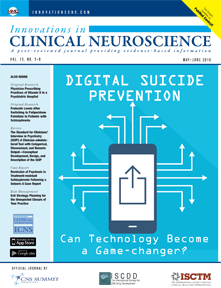 Innov Clin Neurosci. 2016;13(5–6):13–14
Innov Clin Neurosci. 2016;13(5–6):13–14
Dear Editor:
Brown and Rais[1] offer an interesting case report of the autistic son of a mother with a “multisystem litany of symptoms and diseases… typical for a patient with a mitochondrial disease,” including vasovagal syncope (a sudden, systemic hypotension), dysautonomia (dysfunction of the autonomic nervous system), adrenal insufficiency, central sleep apnea, paroxysmal atrial fibrillation, hypothyroidism, and early onset cataracts [see Innov Clin Neurosci. 2015;12(9-10):29–32]. The authors postured that the underpinning heritability of autism spectrum disorders (ASD) may be through undiagnosed maternal mitochondrial disease. Inasmuch as the aforementioned symptoms may be associated with mitochondrial dysfunction, it should also be recognized that many of these symptoms, including mitochondrial disease itself, can arise from maternal exposure to certain air pollutants previously implicated in the etiopathogenesis of ASD.
The author of this letter has previously been the first to suggest that gestational exposure to the increasing air pollutant (and mild medical anesthetic and analgesic) nitrous oxide (N2O) may be the dominating influence in the pathological development of an ASD phenotype, as well as other neurodevelopmental disorders.[2] Nitric oxide (NO) is a gaseous biological messenger in vertebrates, perhaps most widely appreciated for its role as a potent systemic vasodilator. Elevated serum NO levels in ASD may arise from the compensatory formation of central oxidative stress markers attributable to N2O-mediated neuronal cholinergic inhibition.[2] Nisoli and Carruba[3] discuss the role that excess NO may have in mitochondrial dysfunction, including binding to cytochrome oxidase c (complex III) and inhibiting cell respiration. It is interesting that ASD has been associated with deficiencies in the mitochondrial respiratory chain, especially complexes III and IV.[4] Moreover, NO has been implicated in cataract formation,[5] adrenal insufficiency,[6] parasympathetic dominance[7] (with enhanced vagal tone thought to play a role in atrial fibrillation8). The author has also highlighted a potential role of N2O exposure and induction of hypothyroxinemia.[9] Others have pointed to an increase in obstructive sleep events in man may be attributable to N2O inhalation.[10]
What these many studies suggest is that Brown and Rais[1] may be well-served by reevaluating the singular importance placed upon mitochondrial disease in ASD. The aforementioned evidence avails a potential important confounder to this hypothesis and suggests that, in accord with the emerging literature on the link between ASD risk and air pollution, chronic exposure to increasing environmental N2O may elicit a litany of physiological effects in man, including mitochondrial dysfunction and attendant comorbidities, while simultaneously instituting a fetal neuro-reprogramming during gestation that is wholly consistent with ASD.
References.
1. Brown BD, Rais T. Autism in the son of a woman with mitochondrial myopathy and dysautonomia: a case report. Innov Clin Neurosci. 2015;12(9-10):29–32.
2. Fluegge K. A reply to ‘Metabolic effects of sapropterin treatment in autism spectrum disorder: a preliminary study.’ Transl Psychiatry. 2016; doi:10.1038/tp.2016.24
3. Nisoli E, Carruba MO. Nitric oxide and mitochondrial biogenesis. J Cell Sci. 2006;119:2855–2862.
4. Guevara-Campos J, González-Guevara L, Briones P, et al. Autism associated to a deficiency of complexes III and IV of the mitochondrial respiratory chain. Invest Clin. 2010;51(3):423–431.
5. Ito Y, Nabekura T, Takeda M, et al. Nitric oxide participates in cataract development in selenite-treated rats. Curr Eye Res. 2001;22(3):215–220.
6. Wang CN, Duan GL, Liu YJ, et al. Overproduction of nitric oxide by endothelial cells and macrophages contributes to mitochondrial oxidative stress in adrenocortical cells and adrenal insufficiency during endotoxemia. Free Radic Biol Med. 2015;83:31–40.
7. Chowdhary S, Vaile JC, Fletcher J, et al. Nitric oxide and cardiac autonomic control in humans. Hypertension. 2000;36(2):264–269.
8. Van den Berg MP, Hassink RJ, Baljé-Volkers C, Crijns HJGM. Role of the autonomic nervous system in vagal atrial fibrillation. Heart. 2003;89(3):333–335.
9. Fluegge K. Maternal hypothyroidism and risk of autism. BJOG-Int J Obstet Gy. 2016; doi: 10.1111/1471-0528.13955
10. Beydon L, Goldenberg F, Heyer L, et al. Sleep apnea-like syndrome induced by nitrous oxide inhalation in normal men. Respir Physiol. 1997;108:215–224.
With regard,
Keith Fluegge
Institute of Health and Environmental Research, Cleveland, Ohio
Funding/financial disclosures. The author has no conflicts of interest relevant to the content of this letter. Similar manuscripts related to this hypothesis may be under review, in press, or published elsewhere, although the specific content contained in this letter is original and not in review or previously published. This letter is intended for journal publication.
Author Response.
Dear Editor:
Fluegge offers a novel hypothesis for the etiology of ASD: that gestational exposure to the air pollutant nitrous oxide may be an important factor. However, in our case report we discuss a case of mitochondrial disease across two generations, making inheritance a more likely explanation than in-utero exposure, which would not explain the patient’s mother’s illness. Further, neither the patient nor his mother had any known or recorded nitrous oxide exposure history.
The pathophysiology of ASD is mostly unknown, but it is doubtless complex and multivariate. Our article made no definitive statement about the singular importance of one factor or another in the pathophysiology of ASD. Our goal as clinicians was to raise awareness about the correlation between ASD and mitochondrial disease to improve diagnostic analysis of patients with ASD and avoid misdiagnosis in this population. This goal can be achieved without wading into unknown or speculative territory with regard to the etiology and pathophysiology of ASD. We are content to leave that work to Dr. Fluegge.
With regard,
Bradley D. Brown, MD
From University of Toledo Medical Center, Toledo, Ohio
Funding/financial disclosures. The author has no conflicts of interest relevant to the content of this article/letter.




